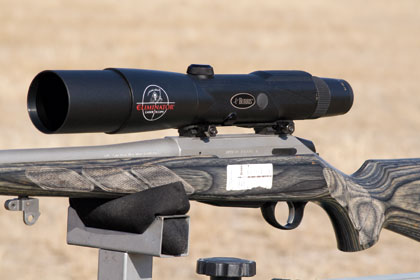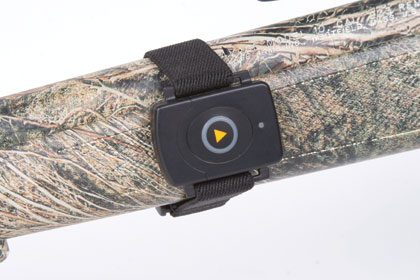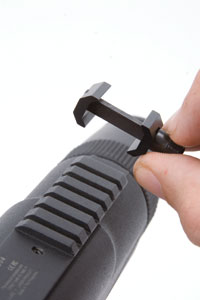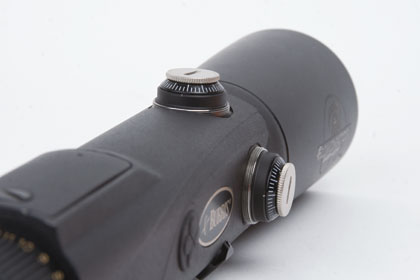September 23, 2010
By J. Guthrie
The Burris Eliminator was 15 years in the making, and it packs a pile of gear into one new riflescope. The author's extensive tests proved the system was fast, accurate, and simple to use.
By J. Guthrie
 The new Burris Eliminator proved to be practical and fast in the field. The author had a range and the correct aiming point with the touch of one button and was able to make a perfect shot on this Wyoming antelope. |
You can always tell when a shooter is serious about hitting long-range targets on the first shot. In terms of equipment, his rifle has the all the telltale signs of lots of shooting--a shiny bolt handle, missing finish on the sharp edges, and a cheat sheet with bullet drops taped to the stock. A few boxes of premium or match-grade ammunition or, even better, carefully assembled handloads sit on the bench within arm's reach and are all that will ever grace the rifle's chamber. The riflescope has a mil-dot or drop-compensating reticle and, if the rifleman is really on his game, target turrets that make exact windage and elevation adjustments possible. A laser rangefinder, the device that put long-range accuracy within reach of most riflemen, will be close at hand as well. The really tech-savvy guys will have a Kestrel wind and weather meter and maybe even a PDA with the latest ballistic software installed.
All of this equipment has one purpose, to tell the rifleman exactly where the bullet will fall at a distant range. With the exception of judging wind and having the ability to shoot well in the first place, knowing the bullet's drop at a given range is the key factor to long-range accuracy. Shooters can take the range; factor in variables like elevation, temperature, and angle; compare the data against a drop chart generated by ballistics software; and then come up with that magic number of clicks or the precise spot on a reticle where the bullet will land.
Advertisement
 Though the Eliminator comes factory-set to display a Ballistic-Plex-type series of illuminated dots, you'll want to program the reticle to your particular rifle and load. Once programed, your reticle will display like the above right version. |
What if one instrument gathered the data and did most of the calculating for you, and at the speed of light? Burris has created a scope that does just that. The Eliminator, introduced at this year's SHOT Show, combines a riflescope, a laser rangefinder, an inclinometer, and ballistics software and projects on its reticle exactly where a bullet will fall at a given range and does so almost instantaneously. The catch is there is no catch. The system is simple, fast, field portable--in a word, practical--and unbelievably inexpensive.
Range Introduction
Last fall a group of us pulled up to an impromptu shooting range in Wyoming on a blustery day and piled out of a rental. We were hunting antelope with the Burris sales and technical support team, and they had promised to roll out the next big thing in optics. In a business where gaining an extra 2 percent in light transmission or increasing magnification range is a huge technical achievement, the "next big thing" is often a snoozer for the majority of the shooting public.
Advertisement
Patrick Beckett, a 15-year Burris veteran who now holds the title of vice president of sales and marketing, had promised more and led me to a shooting bench topped with a Tikka T3 chambered in 7mm Magnum. Having never hunted with that particular caliber, I was honestly more excited about the chambering than the scope. Atop the Tikka was a Burris Laser Scope, no surprise since Burris was sponsoring the hunt. Beckett asked me to check my zero on a target placed at 100 yards. My three shots went into a nice 1-inch group that was perfect in terms of elevation and only a half-inch or so right of the bull.
"Now shoot the 500-yard target," he said, not an ounce of just kidding in his voice. Out past several 3D whitetail targets with steel centers sat a 14x14-inch steel swinger, wearing a fresh coat of white spray paint.
I had noticed a drop chart taped on the Tikka's stock before shooting and rolled the rifle over thinking I could find the data for the Hornady 139-grain GMX there. The data was there but not familiar to me, with little dots accounting for the standard 100-yard increments out to 500 yards.
 The Eliminator combines a laser rangefinder, inclinometer, ballistic computer, and an innovative OLED aiming system. It ranges, computes the drop, and displays an illuminated aiming point. |
"The scope will tell you where to hold," Beckett said, a little amused.
This was no ordinary Laser Scope, but the new Eliminator. Beckett explained that I just needed to press the ranging button and the scope would take the range and angle and compare it against a selected and stored ballistic curve and then give me an aiming point, the aiming point being a small orange/red dot on the vertical stadia. I ranged the plate at 533 yards, and a dot appeared as promised. I centered the dot, squeezed, and the crisp trigger broke a few seconds later. Because of the distance, I had enough time to recover, and I saw the bullet strike the swinger's right-hand edge. Quickly chambering another round, I held on the left-hand edge to account for wind, and my less-than-perfect zero, and got a center hit. Walking back through the targets sprinkled across the range, first-round, center-mass hits were easy, almost monotonous. Opening the bolt and setting the rifle aside to cool, my questions were already boiling over.
Unlike many other new products I have tested over the year, the concept was more practical than novel and one, I soon learned, that took 15 years to reach fruition.
"When hand-held rangefinders came out 15 years ago, we wanted to get a rangefinder in a riflescope," Beckett said. "We wanted automatic range compensation at the same time, but that was a pipe dream back then. There had to be thousands of other guys running around the woods thinking the same thing. The catch was getting there."
 The Eliminator comes with a small remote that can be strapped to the rifle's fore-end for at-your-fingertips operation. |
The first steps toward the Eliminator were made five years ago with the Laser Scope's introduction. Having used the Laser Scope prior to my Wyoming excursion, I knew the system to be pretty good. To make it more affordable, the development and production costs of bringing laser scopes to the market were shared between Burris, Bushnell, and Nikon. With the Laser Scope up and running, Burris engineers immediately started work on the Eliminator. All of the components existed, in one form or another, but had never been crammed into one optic and made to work together.
The big breakthrough was finding a way to display the aiming point. Looking through the Eliminator, it appears to have a standard, floating etched reticle. A closer look reveals tiny lines in a herringbone pattern on each side of the vertical stadia below the crosshair's intersection. Those tiny lines carry power to 38 organic light emitting diodes (OLEDs). OLEDs have some big advantages over liquid crystal displays (LCDs) commonly used in other optical devices. They do not require a backlight, and components are smaller and thinner. While emitting less light than solid-state LEDs, the OLEDs' emissive electroluminescent layers are made from organic compounds, hence the name, and one of those layers is transparent. That transparency allows the scope to increase its light transmission markedly.
"The OLED really made the Eliminator possible," Beckett said. "With an OLED only a very small percentage of the reticle is blocking light, really only the vertical post, which has always blocked light in scopes. We get around 90 percent light transmission."
Placed over the standard etched reticle and held in place with an epoxy, the strip of OLED aiming points is no larger than the opposing stadia. Since there is a constant black background, they are sufficiently bright, even in bright sunlight, eliminating the need for a rheostat to control dot brightness. The 1/3-minute dots are sufficiently small to provide a very precise aiming point, especially considering the drop-compensating system only works at the Eliminator's 12X setting.
 Two Weaver or Picatinny compatible clamps hold the Eliminator on the mounts and are tightened with a beefy nut. |
"The bottom dot represents up to 63 inches of drop at 500 yards with a 100-yard zero," Beckett said. "This covers most centerfire calibers, from .17 Remington to .50 BMG, and only puts cartridges like the .30-30 or .45-70 loaded with flatnose bullets out of our reach, and very few people are shooting those calibers out to 500 yards. The system also doesn't work well with rimfires, obviously."
Sitting between the laser rangefinder and the aiming dots is a microprocessor. That processor takes the range and references a previously selected ballistic drop table, converting the yardage into a point on the reticle. The on-board memory stores 40 different tables--from an astoundingly flat 23-inch drop to the aforementioned 63-inch drop--generated by Exbal Ballistics. Burris had worked with Exbal on several other projects and figured on keeping a proven system in play.
"We had to add components and more memory to the boards for the additional computing," Beckett said. "The system is extremely fast and delivers an aiming point at the same time as it displays the range."
Another handy component included is an inclinometer. Without it shooters sending rounds downrange at extreme angles would be tasked with first determining the shot angle and then the true distance to target using--gasp--some basic trigonometry. Remember it is gravity that pulls bullets down to Mother Earth, so the line-of-sight distance will not work if the angle is extreme. While it is highly unlikely the Eliminator would have improved my grade in Trig class, it does allow me to not worry about angles and just shoot.
Engineers were able to pack all this stuff into a slightly modified Laser Scope body. The Eliminator's body is more square than round but only weighs 26 ounces with a CR2 battery installed. For comparison, a 3-12X 44mm Signature Select scope weighs 18 ounces. Overall, the Eliminator saves weight because you can eliminate a handheld rangefinder from your big pile of gear.
Machined from an aluminum casting, the scope has a unique set of precision-engineered optical elements that are fully multicoated. Once finished, the unit is nitrogen purged and as weatherproof as any other Burris riflescope. The objective lens diameter measures a full 42 millimeters, and there are 50 minutes of windage and elevation adjustment.
Thus, integrated into one unit is a proven laser rangefinder, inclinometer, memory containing a bunch of drop charts, microprocessor, and a set of OLEDs. Grand intentions aside, how does it all work outside of the lab?
Setup
The Tikka was set up by someone intimately familiar with the Eliminator system. When a sample showed up on my doorstep, I figured on calling customer service to get squared away since something so complicated must be, well, complicated. Of late, I have taken to reading the provided instructions that come with new products, and it has simplified my life immensely and made me a happier person all around. Read the instructions. They are simple, easy to understand, and will save you a call to customer service.
The first big consideration is that when using common two-piece bases, the front Picatinny or Weaver base should be flipped so that it points rearward. Buying a set of Burris XTB bases will make the process easier, since they were designed to work with both the Laser Scope and the Eliminator. There are almost 6 inches of available rail, so setting eye relief is easy, and the scope sits low on the receiver. Once mounted using the provided rail clamps, zero the rifle at 100 or 200 yards.
 A standard set of windage and elevation knobs are used to zero the rifle just like an ordinary scope. |
With the battery installed, pressing the main switch on the scope's left side will fire up the system. From the factory, there is no ballistic curve assigned to the aiming points, and five different points will illuminate, representing the same points found on the standard Ballistic Plex reticle. But keeping the factory setting would pretty much defeat the purpose entirely.
Pressing the main switch and the forward arrow on the setup button for 6 seconds will send the scope into setup mode. Using various combinations of the up, down, forward, and back arrows will allow one to select meters or yards for range measurements, a 100- or 200-yard zero, and finally the correct ballistic curve represented by the amount of dr
op a given cartridge/bullet combination produces, in inches, at 500 yards with a 100-yard zero.
In the voodoo world of ballistics, one should never take anything for granted, even if a nifty program like Exbal generated the ballistics charts. The final setup step is to check the results at distance and make sure the bullets land where the reticle said they would. After zeroing, start at 500 yards and if bullet strikes are a little high or low, adjust the drop number up or down until it matches.
Field Function
A sample scope was mounted on an old favorite, a Savage Predator in .223 that shoots 1/2-MOA groups with Hornady 55-grain TAP ammo. While pairing the Eliminator and Predator sounded like the basis for a Hollywood blockbuster, in reality it was a great way to see if the system worked. I set up the scope to first measure ranges in yards, selected the 100-yard zero setting, and then plugged in a 500-yard drop of 53 inches using the extensive list of factory load data in the manual. After zeroing the rifle at 100 yards, it was time to see if all worked.
I was only able to scratch out 400 yards and found the point of impact at that range to be 1.5 inches low. Differences between the theoretical 500-yard drops provided by the load data and what real-world rifles actually shoot will be a common occurrence when factors like barrel length, sight height, muzzle velocities, elevation, and actual--not theoretical--ballistic coefficients get through playing havoc with a bullet's flight. To account for the difference, I dropped the drop number down two notches to 55. With my 400-yard point of impact dialed in, I backed up to 320 yards, then 248 yards, and found the bullet's point of impact to be within an inch of my aiming point. After trying the Eliminator on another favorite, a Remington 700 Police in .308, with similar results, I was convinced Burris had a system that worked.
Hunting with the Eliminator further validated the manufacturer's wild claims of simple and easy. I shot a nice pronghorn by simply putting the crosshairs on its hide, pressing the ranging button, and then placing the aiming point on its vitals. While the range was not excessive at just 140 yards, neither was my pile of gear. Gone were the laser rangefinder and ballistic chart, and knowing the bullet trajectories were programmed in allowed me to worry about cacti not inches of drop. I think the Eliminator will really come into its own on future coyote hunts, given their fast pace.
The only downsides are a scope that weighs a few ounces more than comparable models and a battery that can fail. The CR2 generates around 1,100 cycles, but that can vary depending on ambient temperatures. Should the battery die, the settings are stored and then restored after you find the spare battery buried in the bottom of your pack. If the extra hand movement to punch the main switch button for a range reading worries you, the unit comes with a remote that can be attached via hook-and-loop fasteners on the fore-end for easy and near-motionless activation.
The aiming point stays on for 80 seconds, plenty of time to pull off the trickiest long-range shot. The Eliminator does not account for that most dastardly of variables, wind. You are on your own there. And just what does this technological marvel cost? The MSRP is around $1,200, but street price runs between $850 and $950. Beckett admitted to taking a beating on margins in an effort to get the Eliminator in as many hands as possible.
"We've done our homework," Beckett said. "There is a lot to shooting at long ranges, and the scope takes care of most of that. The magic is the scope's simplicity, not its complexity."
The Eliminator is an exceptional system that gives shooters the ability to quickly range and then accurately place bullets with common hunting cartridges and bullets out to 500 or 600 yards. It eliminates several other pieces of equipment and is simple to set up and use. And in these trying economic times, it is affordable.

